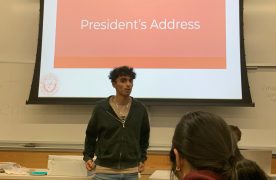The story of humanity’s own origins is the original family tree. This genealogy is rooted in murky mythology. Its branches are the diverse brands of mysticism and materialism, spontaneous generation, special creation and other now-discredited hypotheses.
At the furthest height of this understanding is the contemporary and presumably correct view that homo sapiens has evolved, as all organisms have and continue to do, from dissimilar ancestors. But as time passes and new ideas are presented, the explanation of our species’ origin inevitably evolves. Professor Michel Brunet of the University of Poitiers, France has forced us to change our conception of the human family tree.
Brunet is the director of a scientific collaboration between the University of Poitiers and the University of N’Djamena and National Center for Research Support in Chad. In July, this international project — involving 40 scientists from 10 countries — released news that their work concerning early hominid origins and environments had led to the discovery of a new hominid in the Djurab desert of Northern Chad.
A nearly complete cranium, two lower jaw fragments and three isolated teeth represent the new species as it is described by Brunet and his colleagues in the July 11, 2002 issue of the journal Nature. The creature, a hominid, and therefore a member of the same evolutionary lineage that includes human beings, has been nicknamed Toumaï after a suggestion by Chad authorities. Toumaï, a name given to babies born in this desert region before the dry season, means “hope of life” in the Goran language.
One of the most significant aspects of this discovery is the age of Toumaï. Its apparent antiquity has refined the estimates of the time since the most recent common ancestor of chimps and humans provided by common molecular methods.
By multiplying the number of differences in two species’ genomes by the amount of time it takes for any one mutation to occur, scientists can approximate the amount of time it took for the total number of differences to accrue. This is the time elapsed since the most recent common ancestor of, for example, humans and chimps diverged into the two separate lines.
Although the local geology did not allow scientists to use radiometric dating techniques, the remains of many other species of animals permitted the application of faunal correlative methods. The hippopotamuses, antelope, boar, rodents, monkeys and other fauna found at the site are of known age, and since Toumaï was found among them, its estimated age is thought to be the same: close to seven million years old. The more recent divergence implied by the molecular method is pushed back by this fossil evidence for a more ancient split.
Professor Laura MacLatchy is an associate professor with Boston University’s Department of Anthropology and has done extensive field work in Africa focusing on primate and hominid species. She was able to explain how the paleobiological context of Toumaï affects molecular estimates of the age of hominids.
“There have been numerous molecular estimates, and they always cover a range of dates. Many have accommodated a seven million year split (7-5 Ma has been cited). So, this new fossil suggests that the older estimates were more correct. It’s important to remember that all molecular branching time estimates require calibration with the fossil record, and that this is one source of variation,” MacLatchy said.
One of the features Toumaï shares with its more contemporary relatives, humans included, is its teeth. According to Brunet, the fossil evidence shows some dental characters that the creature shares exclusively with later hominids.
Professor Timothy White, of the Department of Integrative Biology at the University of California (Berkeley), has collaborated with Brunet’s team to analyze fossil material from hippos, anteaters and rodents. He praised this work as being representative of anthropology’s contribution to culture by aiding an understanding of human origins.
“Anthropology shows that people everywhere want to contextualize their existence,” White said. “Hundreds of myths about where we came from have been spun, but only one can be right. The way to know where we came from is through paleoanthropology. In addition to satisfying innate curiosity, this basic research, like all basic research, has unpredictable consequences and applications. Nobody knew what we could do with unraveling the structure of DNA or inventing the laser—both basic research.”
The Djurab desert is in the central African nation of Chad, hundreds of kilometers west of the Rift Valley renowned for the richness of its fossil hominid material.
“We have known for a long time, since the beginning of the 20th century, through geological and hydrogeological reports that there are fossils there,” Brunet said.
This geographic location suggests that rather than inhabiting a limited area in East Africa, ancient hominids may have roamed throughout Africa.
“I see the significance of this find as drawing attention to what the [Djurab] site will yield in the way of knowledge as it is worked subsequently. The cranium is therefore sort of an ‘announcer’ or ‘ambassador’ opening a door on the past.” White said.
MacLatchy explained how the discovery of another, and very ancient, hominid species, distorts the hominid family tree as we know it:
“One of the biggest implications of the find is perhaps that there is no longer a single ‘tree.’ The picture is so complex that there are numerous ways we can fit existing fossils into a phylogeny [tree] and we don’t have any way to distinguish among all the possible permutations. This sentiment has been building in the discipline for some time, and now is very apparent.”
Further work needs to be done until Toumaï’s possible role in evolution is completely understood. Brunet’s pigeon-holing of Toumaï into the family Hominidae may be contested as the evidence is analyzed further.
“Right now, we are pretty certain it is a hominid, but not positive,” MacLatchy said. “I saw a cast of the skull last fall. The base of the skull is damaged, so the position of the foramen magnum, which is used to infer whether this specimen is from a biped, is difficult to reconstruct. And the crowns of the teeth are not present on the skull, so dental features, such as canine reduction, which are so important in determining phylogenetic affinities in hominids, also must be reconstructed to a degree. So, it will be extremely important in the next few years to see what else is recovered.”
Toumaï will continue to be studied, with research focusing on anatomy phylogeny, paleohistory, dental wear, and other issues currently in progress. Brunet believes the site will be able to yield fossils from even earlier periods that will no doubt confirm the current belief that Central Africa was a crossroads of animal exchange between northern and eastern Africa at times three-to-seven millions years ago. Brunet said he is convinced the study of such faunal exchange mechanisms and dynamics is a key to a more accurate understanding of the origin and spreading of the first founding members of the human lineage, and consequently of the entire hominid history.
This is an account occasionally used by the Daily Free Press editors to post archived posts from previous iterations of the site or otherwise for special circumstance publications. See authorship info on the byline at the top of the page.












